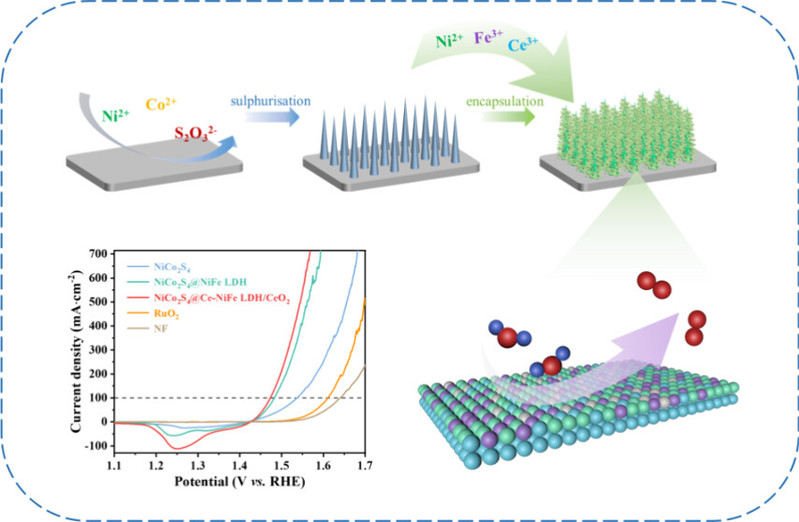Self-Supported NiCo2S4@Ce-NiFe LDH/CeO2 Nanoarrays for Electrochemical Water Splitting
Jun Yu1, Nannan Zhang1, Jie Li1, Huiyu Sun1, Xinyu Gu1, Zhengying Wu2(吴正颖)*, Tianpeng Liu1, Yukou Du1(杜玉扣)*
1College of Chemistry, Chemical Engineering and Materials Science, Soochow University, Industrial Park, Renai Road, Suzhou 215123, P.R. China
2Jiangsu Key Laboratory for Environment Functional Materials, School of Materials Science and Engineering, Suzhou University of Science and Technology, Suzhou 215009, China
Inorg. Chem.2025, 64, 8971–8980
Abstract: The design of high-performance OER catalysts is crucial for efficient electrochemical water splitting (EWS). Herein, a NiCo2S4@Ce-NiFe LDH/CeO2 heterostructure nanoarray electrocatalyst with abundant oxygen defect sites is reported. The introduction of Ce species activates the lattice oxygen in the oxyhydroxides, inducing the transformation of the catalytic mechanism toward the lattice oxygen oxidation mechanism (LOM) pathway, bypassing the thermodynamic limitation of the adsorbate evolution mechanism (AEM), and strengthening the intrinsic activity of the material. Moreover, the reversible transitions between different oxidation states of Ce species and the high oxygen storage capacity of CeO2 regulate the adsorption behavior of the reaction intermediates, allowing it to be easier for the material to enrich the oxygen-containing intermediates, thereby improving the adsorption kinetics. Accordingly, NiCo2S4@Ce-NiFe LDH/CeO2 exhibits remarkable OER performance (η50 = 226 mV, η100 = 244 mV) and brilliant stability. Additionally, the presence of the CeO2 protective layer inhibits the impact of Cl– and other pollutants in seawater, which enables NiCo2S4@Ce-NiFe LDH/CeO2 to perform satisfactorily in seawater electrolysis, as well. This study offers a fresh perspective on the design of defect-rich OER catalysts.

Article information: //doi.org/10.1021/acs.inorgchem.5c00289